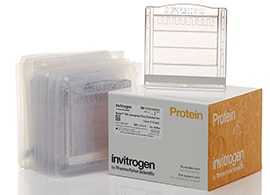Search

Invitrogen Novex Zymogram Gels are excellent tools for detecting and characterizing proteases that utilize casein or gelatin as a substrate.
Novex Zymogram Gels are excellent tools for detecting and characterizing proteases that utilize gelatin as a substrate. Novex Zymogram Gels can be used to analyze a variety of enzymes, including matrix metalloproteinases, lipases, and other proteases. Novex Zymogram Gels are based on tris-glycine gel chemistry containing gelatin as the substrate.
How Novex Zymogram Gels work
Protease samples are denatured in SDS buffer under non-reducing conditions and without heating, and run on a Novex Zymogram Gel using tris-glycine SDS running buffer. After electrophoresis, the enzyme is renatured by incubating the gel in Invitrogen Novex Zymogram Renaturing Buffer, which contains a nonionic detergent. The gels are then equilibrated in Invitrogen Novex Zymogram Developing Buffer to add divalent metal cations required for enzymatic activity, and then stained and destained. Regions of protease activity appear as clear bands against a dark blue background where the protease has digested the substrate.
| Available gel size | Mini: 8 cm x 8 cm (1 mm thick) |
| Storage conditions | 2–8°C |
| Shelf life | 2 months |
| Gel chemistry | Tris-glycine–containing gelatin or casein |
| Running buffer | Tris-glycine SDS running buffer |
| Available polyacrylamide concentrations | 10% (w/gelatin) |
| Separation range | 10–220 kDa |
| For use with (equipment) mini gels | Mini Gel Tank or XCell SureLock Mini-Cell |
| Mode of separation | Molecular weight |
| Zymogram Gelatin Gel | |
|---|---|
| Gel composition | 10% tris-glycine gel |
| Substrate | 0.1% gelatin |
| Sensitivity | 5 x 10-6 units of collagenase |
| Post-staining required | Yes |
| Separation range | 20–120 kDa |
Novex Zymogram Gels are excellent tools for detecting and characterizing proteases that utilize gelatin as a substrate. Novex Zymogram Gels can be used to analyze a variety of enzymes, including matrix metalloproteinases, lipases, and other proteases. Novex Zymogram Gels are based on tris-glycine gel chemistry containing gelatin as the substrate.
How Novex Zymogram Gels work
Protease samples are denatured in SDS buffer under non-reducing conditions and without heating, and run on a Novex Zymogram Gel using tris-glycine SDS running buffer. After electrophoresis, the enzyme is renatured by incubating the gel in Invitrogen Novex Zymogram Renaturing Buffer, which contains a nonionic detergent. The gels are then equilibrated in Invitrogen Novex Zymogram Developing Buffer to add divalent metal cations required for enzymatic activity, and then stained and destained. Regions of protease activity appear as clear bands against a dark blue background where the protease has digested the substrate.
| Available gel size | Mini: 8 cm x 8 cm (1 mm thick) |
| Storage conditions | 2–8°C |
| Shelf life | 2 months |
| Gel chemistry | Tris-glycine–containing gelatin or casein |
| Running buffer | Tris-glycine SDS running buffer |
| Available polyacrylamide concentrations | 10% (w/gelatin) |
| Separation range | 10–220 kDa |
| For use with (equipment) mini gels | Mini Gel Tank or XCell SureLock Mini-Cell |
| Mode of separation | Molecular weight |
| Zymogram Gelatin Gel | |
|---|---|
| Gel composition | 10% tris-glycine gel |
| Substrate | 0.1% gelatin |
| Sensitivity | 5 x 10-6 units of collagenase |
| Post-staining required | Yes |
| Separation range | 20–120 kDa |
资源
仅供科研使用,不可用于诊断目的。




